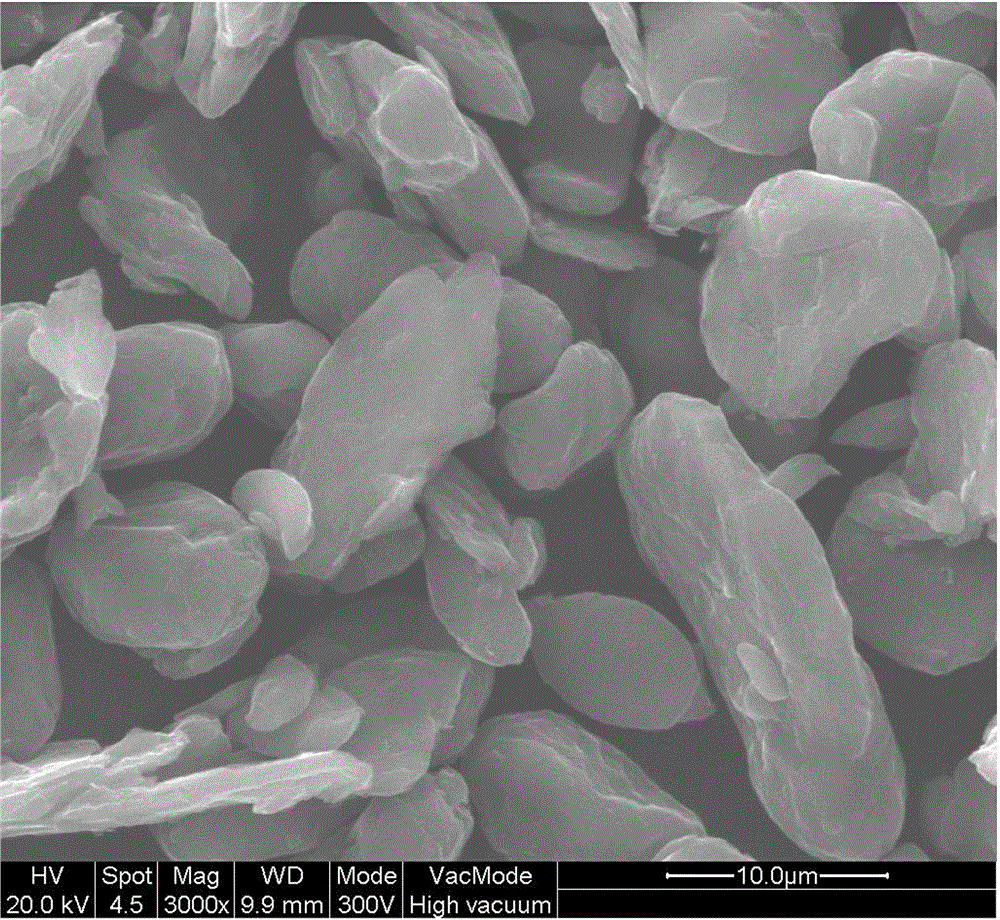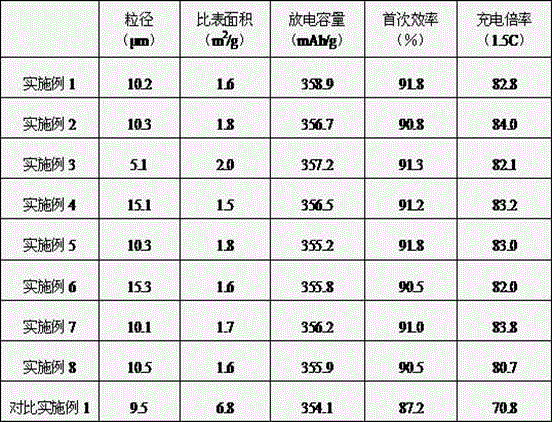Negative electrode material for quickly rechargeable graphite lithium-ion battery and preparation method of negative electrode material
A technology for lithium-ion batteries and negative electrode materials, applied in battery electrodes, secondary batteries, circuits, etc., can solve the problems of fast capacity decay and poor stability, and achieve the effects of simple process, low cost, and high yield
- Summary
- Abstract
- Description
- Claims
- Application Information
AI Technical Summary
Problems solved by technology
Method used
Image
Examples
Embodiment 1
[0041] Put 16kg of petroleum coke (D50 is 6.0μm), 4kg of petroleum pitch (D50 is 4.0μm) and 0.8kg of graphitization catalyst (SiC) into the cantilever double-helix conical mixer and mix for 2 hours, then add it to the kneading pot under stirring Mix and heat to 160° C. for 3 hours of kneading treatment. After the kneading is completed, press into a tablet shape in a tablet machine and pulverize with a hammer mill. Under the protection of nitrogen, heat treatment and granulation were carried out at 500°C for 12 hours, and then the reaction product was cooled to room temperature, and then catalytic graphitization was carried out at 2400°C for 48 hours to obtain fast-charging graphite lithium ion Battery negative electrode material. Its button battery has a capacity of 358.9mAh / g, an initial efficiency of 91.8%, and a charge rate (1.5C) of 82.8%.
Embodiment 2
[0043] Put 16kg of petroleum coke (D50 is 6.0μm), 4kg of coal tar pitch (D50 is 6.4μm) and 0.8kg of graphitization catalyst (SiC) into the cantilever double-helix conical mixer and mix for 2 hours, then add it to the kneading pot under stirring Mix and heat to 160° C. for 5 hours of kneading treatment. After the kneading is completed, press into a tablet shape in a tablet machine and pulverize with a hammer mill. Under the protection of nitrogen, heat treatment and granulation were carried out at 500°C for 18 hours, and then the reaction product was cooled to room temperature, and then catalytic graphitization was carried out at 2400°C for 48 hours to obtain fast-charging graphite lithium ion Battery negative electrode material. Its button battery has a capacity of 356.7mAh / g, an initial efficiency of 90.8%, and a charge rate (1.5C) of 84.0%.
Embodiment 3
[0045] Add pitch coke (D50 is 5.0μm) 10kg, petroleum pitch (D50 is 4.0μm) 10kg and graphitization catalyst (SiC) 0.5kg alternately into the cantilever double-helix conical mixer and mix for 2 hours, then add to the kneading pot under stirring Mix and heat to 100° C. for 10 hours of kneading treatment. After the kneading is completed, press into a tablet shape in a tablet press and pulverize with a hammer mill. Under the protection of nitrogen, heat treatment and granulation were carried out at 700°C for 18 hours, and then the reaction product was cooled to room temperature, and then catalytic graphitization was carried out at 2500°C for 20 hours to obtain fast-charging graphite lithium ion Battery negative electrode material. Its button battery has a capacity of 357.2mAh / g, an initial efficiency of 91.3%, and a charge rate (1.5C) of 82.1%.
PUM
| Property | Measurement | Unit |
|---|---|---|
| particle size | aaaaa | aaaaa |
| particle size | aaaaa | aaaaa |
| particle size | aaaaa | aaaaa |
Abstract
Description
Claims
Application Information
 Login to View More
Login to View More - R&D
- Intellectual Property
- Life Sciences
- Materials
- Tech Scout
- Unparalleled Data Quality
- Higher Quality Content
- 60% Fewer Hallucinations
Browse by: Latest US Patents, China's latest patents, Technical Efficacy Thesaurus, Application Domain, Technology Topic, Popular Technical Reports.
© 2025 PatSnap. All rights reserved.Legal|Privacy policy|Modern Slavery Act Transparency Statement|Sitemap|About US| Contact US: help@patsnap.com



